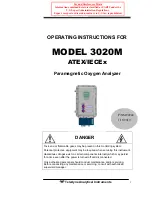
Contact Information
Trimble Navigation Limited
Engineering and Construction Division
5475 Kellenburger Road
Dayton, Ohio 45424-1099
USA
800-538-7800 (toll free in USA)
+1-937-245-5600 Phone
+1-937-233-9004 Fax
www.trimble.com
Legal Notices
Copyright and Trademarks
© 2007-2009, Nikon-Trimble Co. Limited. All rights reserved.
All trademarks are the property of their respective owners.
It is prohibited to alter this manual in part or whole without express
permission.
The contents of this manual are subject to change without notice.
Although every effort has been made to ensure the accuracy of this
manual, please contact your dealer if you find anything in it that is
incorrect or unclear.
Release Notice
This is the November 2009 (Revision A) release of the
Total Station
Nivo Series Instruction Manual
. It applies to software release version
1.0.0 for the Total Station Nivo series.
Manufacturer
Nikon-Trimble Co., Ltd.
Technoport Mituiseimei Bldg.
16-2, Minamikamata 2-chome, Ota-ku
Tokyo 144-0035 Japan
Notices
USA
FCC 15B Class B satisfied.
This equipment has been tested and found to comply with the limits for
a Class B digital device, pursuant to Part 15 of the FCC Rules. These
limits are designed to provide reasonable protection against harmful
interference in a residential installation. This equipment generates, uses
and can radiate radio frequency energy and, if not installed and used in
accordance with the instructions, may cause harmful interference to
radio communications. However, there is no guarantee that interference
will not occur in a particular installation.
If this equipment does cause harmful interference to radio or television
reception, which can be determined by turning the equipment off and
on, the user is encouraged to try to correct the interference by one or
more of the following measures:
– Reorient or relocate the receiving antenna.
– Increase the separation between the equipment and receiver.
– Connect the equipment into an outlet on a circuit different from that
to which the receiver is connected.
– Consult the dealer or an experienced radio/TV technician for help.
C
Warning –
This equipment has been certified to
comply with the limits for a Class B personal
computer and peripherals, pursuant to Subpart B of
Part 15 of FCC Rules. Only peripherals (computer
input/output devices, terminals, printers, etc.)
certified to comply with the Class B limits may be
attached to this equipment. Operation with
non-certified personal computer and/or peripherals
is likely to result in interference to radio and TV
reception. The connection of a non-shielded
equipment interface cable to this equipment will
invalidate the FCC Certification of this device and
may cause interference levels which exceed the
limits established by the FCC for this equipment.
You are cautioned that changes or modifications not
expressly approved by the party responsible for
compliance could void your authority to operate the
equipment.
European Union
EU EMC Directive satisfied.
Authorized Representative in Europe
Trimble GmbH
Am Prime Parc 11
65479 Raunheim, Germany
Canada
This Class B digital apparatus meets all requirements of the Canadian
Interference-Causing Equipment Regulations.
Cet appareil numérique de la Class B respecte toutes les exigences du
Règlement sur le matériel brouilleur du Canada.
Taiwan
Battery Recycling
Requirements
The product contains a removable battery.
Taiwanese regulations require that waste batteries
are recycled.
Notice to Our European Union Customers
For product recycling instructions and more information,
please go to:
www.trimble.com/environment/summary.html
Recycling in Europe
To recycle Trimble WEEE,
call: +31 497 53 2430,
and ask for the “WEEE associate,”
or mail a request for recycling instructions to:
Trimble Europe BV
c/o Menlo Worldwide Logistics
Meerheide 45
5521 DZ Eersel, NL
For Bluetooth unit
USA
FCC Part 15 Subpart C/RSS-210, OET bulletin 65 supplement C
satisfied
C
Caution –
Any changes or modifications not
expressly approved by the party responsible for
compliance could void the user's authority to
operate the equipment.
NOTE: This equipment has been tested and found to comply with the
limits for a Class B digital device, pursuant to part 15 of the FCC Rules.
These limits are designed to provide reasonable protection against
harmful interference in a residential installation. This equipment
generates, uses and can radiate radio frequency energy and, if not
installed and used in accordance with the instructions, may cause
harmful interference to radio communications. However, there is no
guarantee that interference will not occur in a particular installation. If
this equipment does cause harmful interference to radio or television
reception, which can be determined by turning the equipment off and
on, the user is encouraged to try to correct the interference by one or
more of the following measures:
– Reorient or relocate the receiving antenna.
– Increase the separation between the equipment and receiver.
– Connect the equipment into an outlet on a circuit different from that
to which the receiver is connected.
– Consult the dealer or an experienced radio/TV technician for help.
Canada
RSS-210 Low Power Device
Operation is subject to the following two conditions: (1) This device
may not cause interference, and (2) this device must accept any
interference, including interference that may cause undesired operation
of the device.
European Union countries, Iceland, Norway, Liechtenstein,
Turkey, Swiss
EN300 328v1.7.1, EN50360 satisfied
Hereby, Nikon-Trimble Co., Ltd., declares that this instrument is in
compliance with the essential requirements and other relevant
provisions of Directive 1999/5/EC.
Declaration of Conformity available at
http://www.nikon-trimble.com/
RF exposure compliance
1) To comply with FCC/IC RF exposure compliance requirements, a
separation distance of at least 20 cm must be maintained between
the antenna of this device and all persons.
2) This transmitter must not be co-located or operating in conjunction
with any other antenna or transmitter.



































